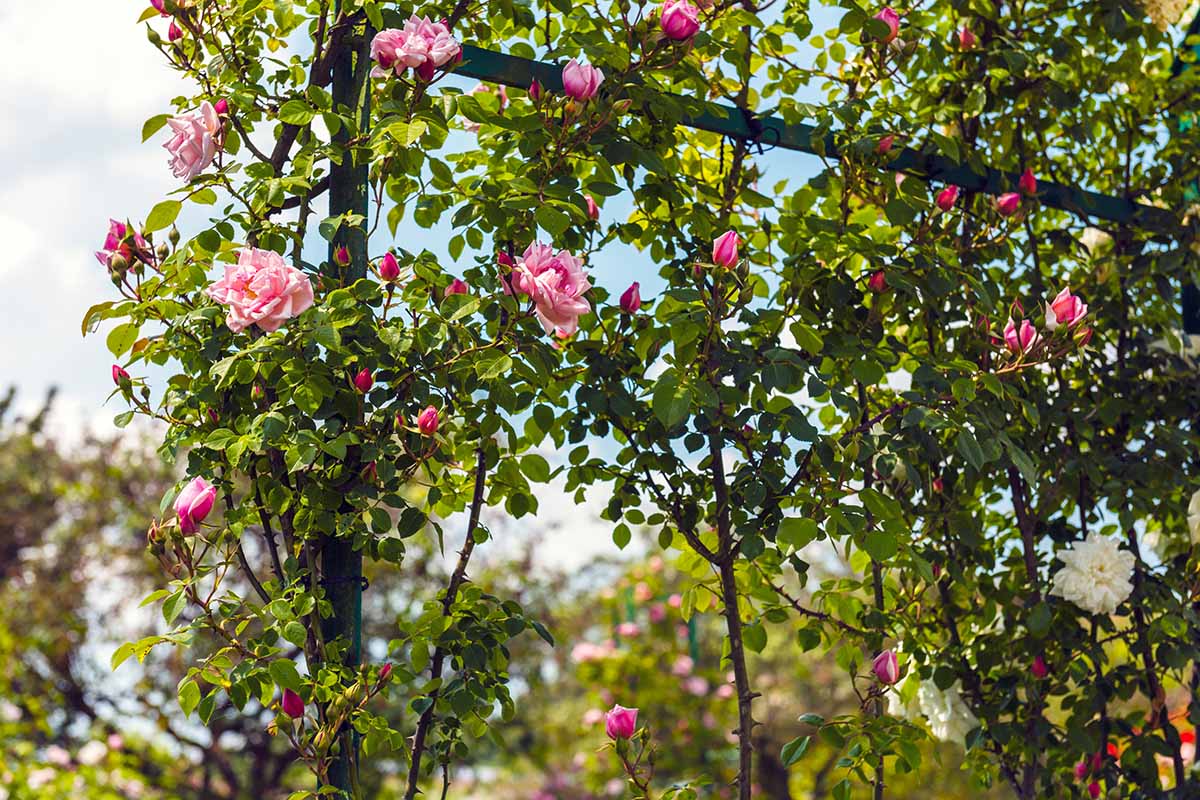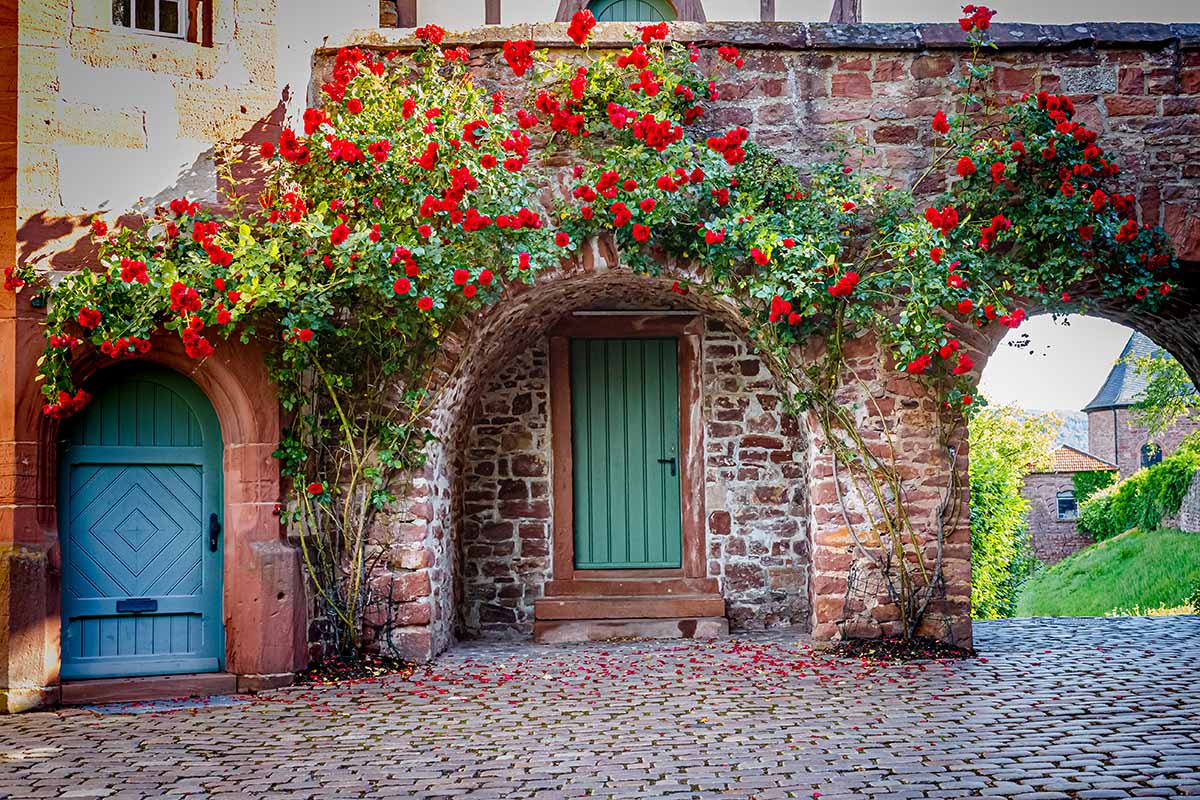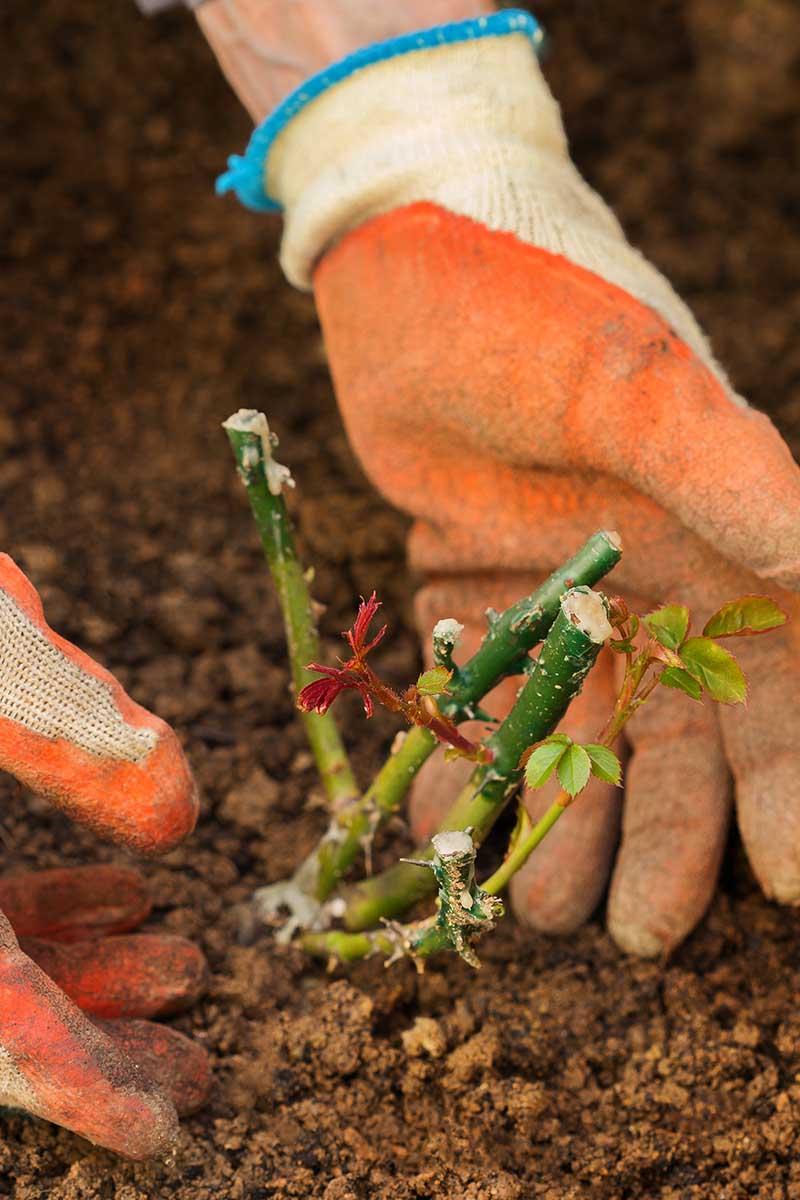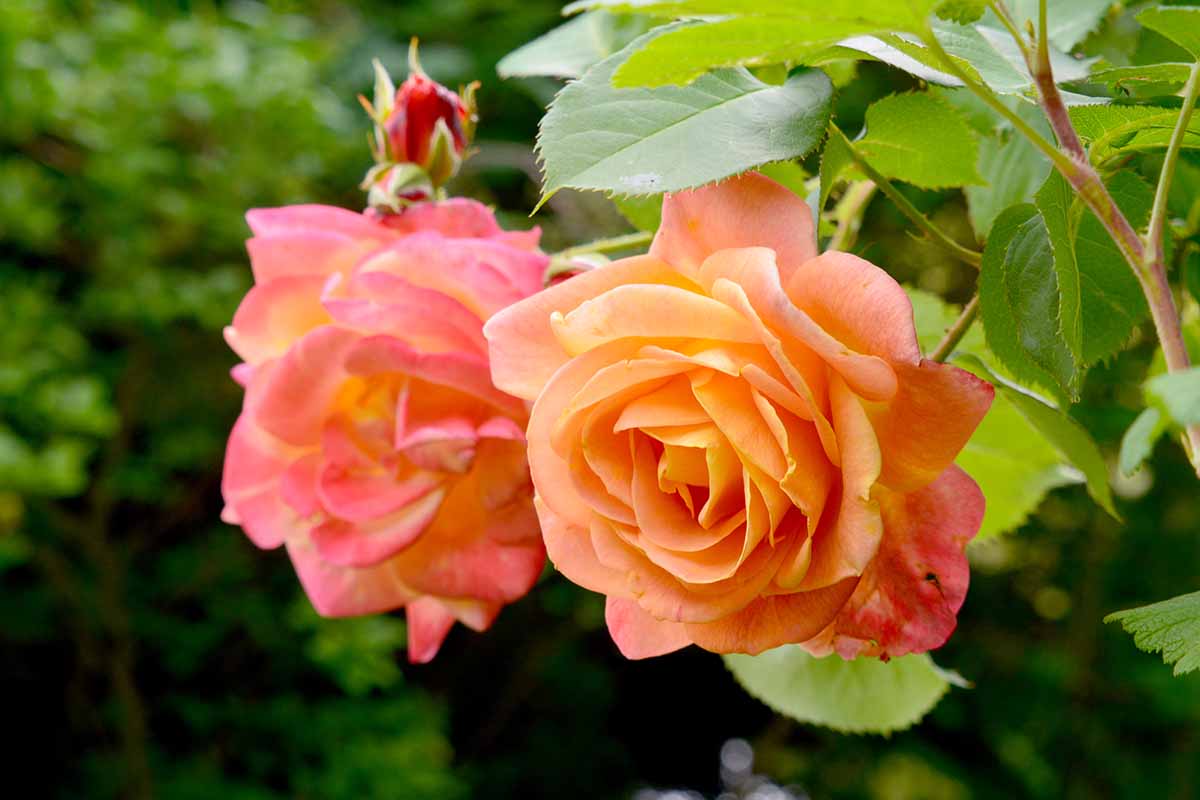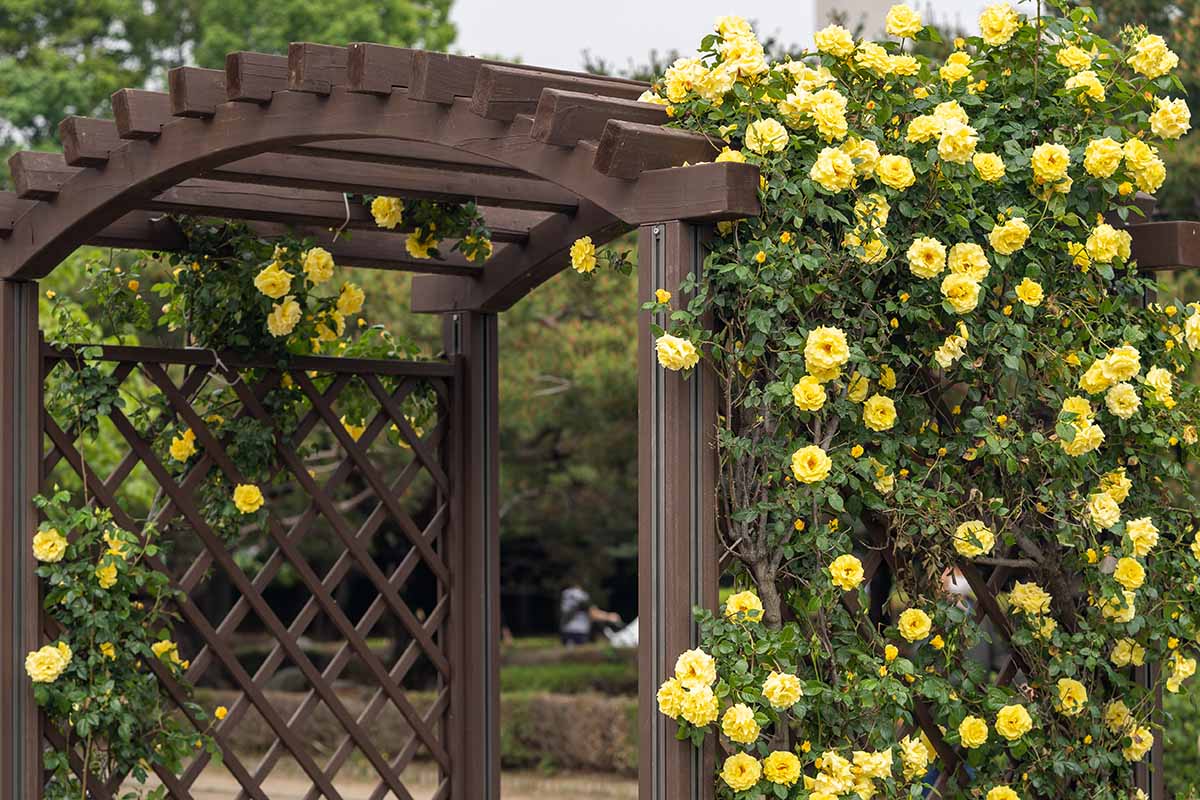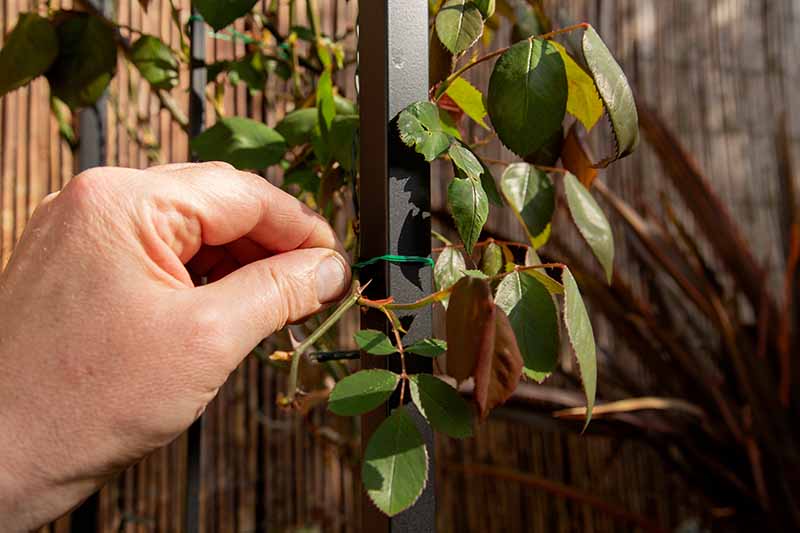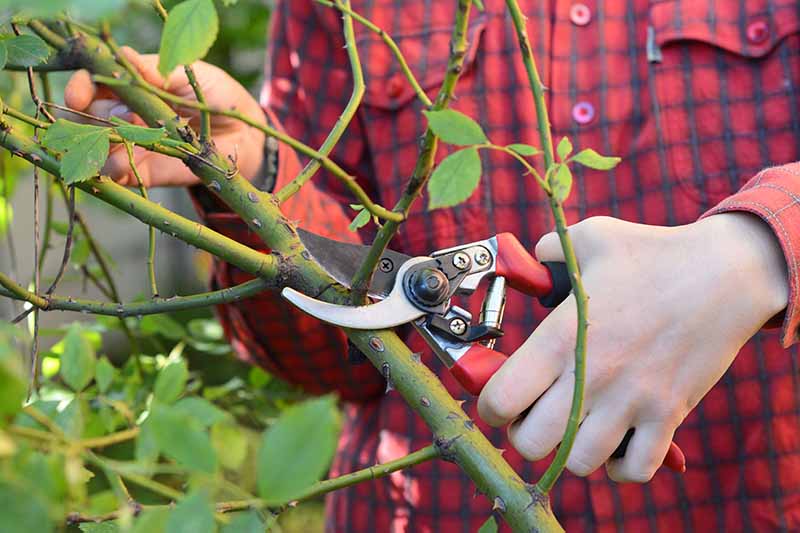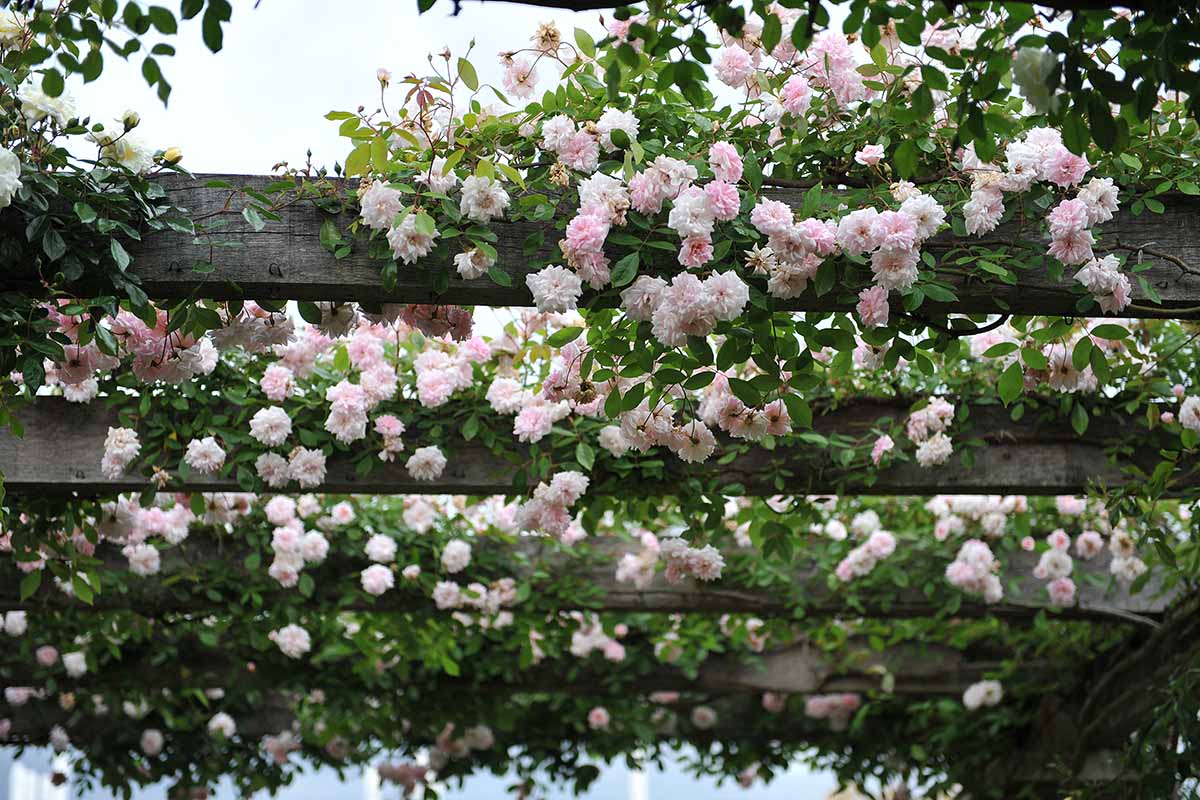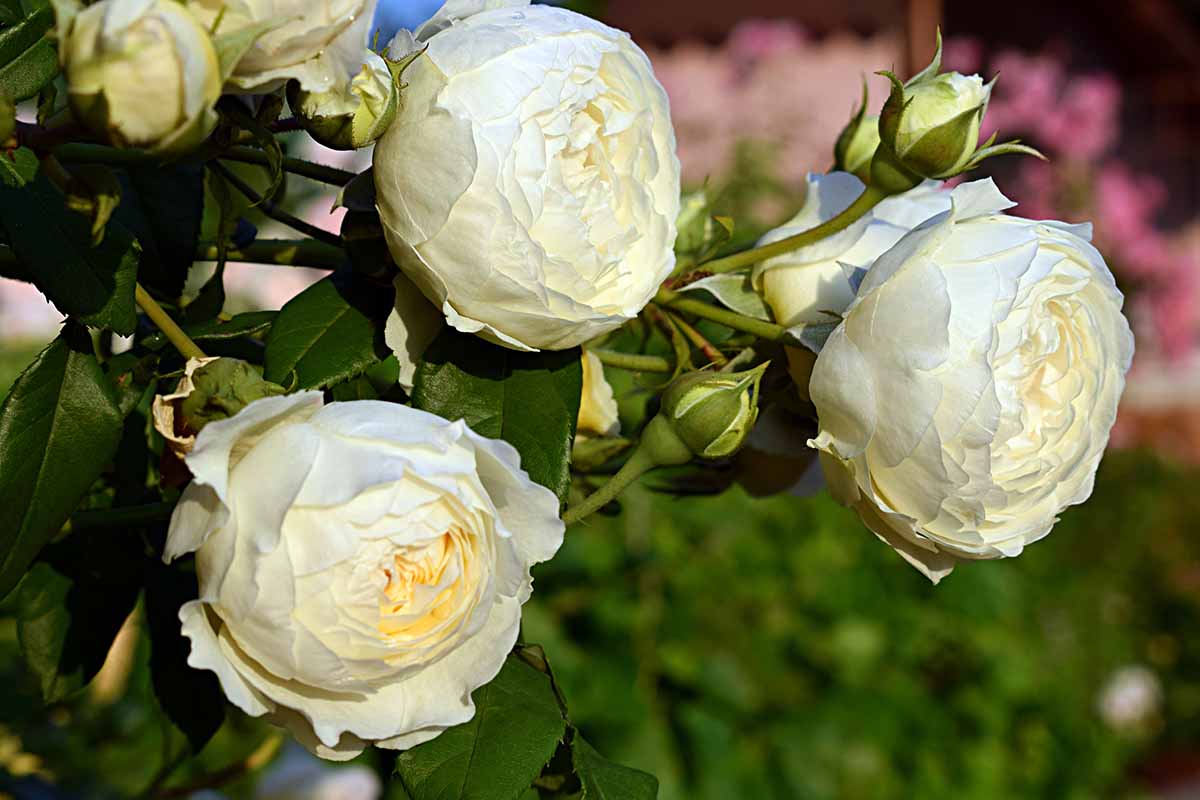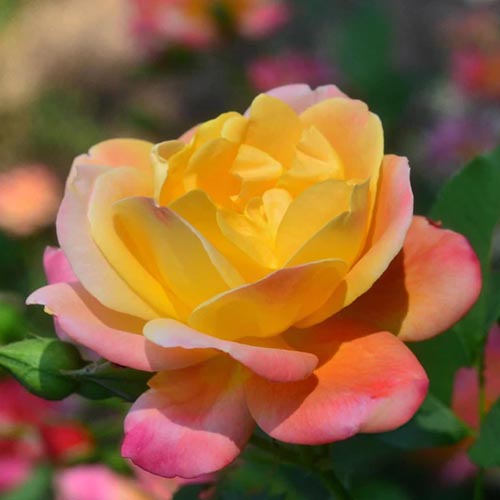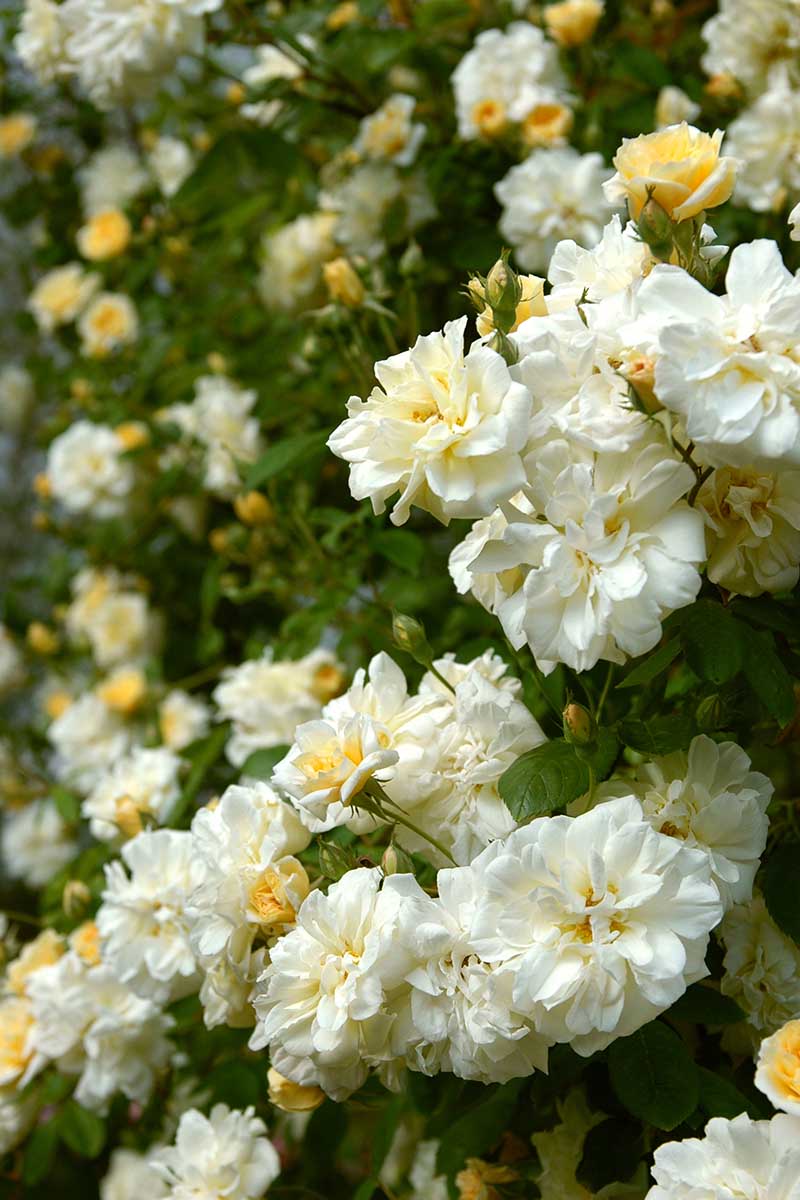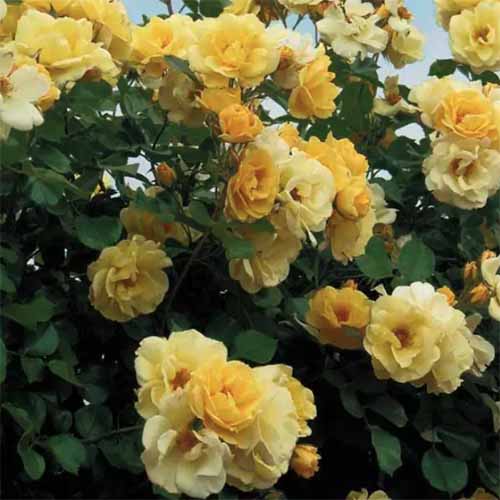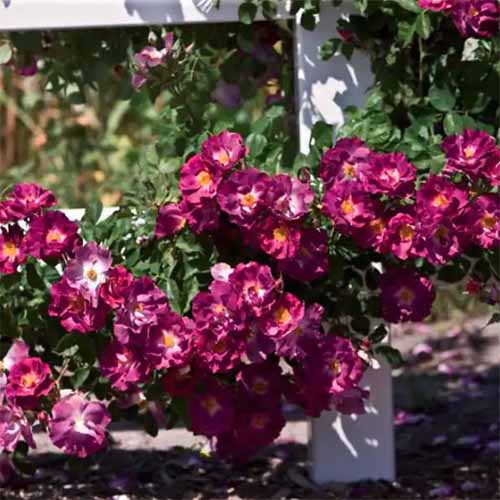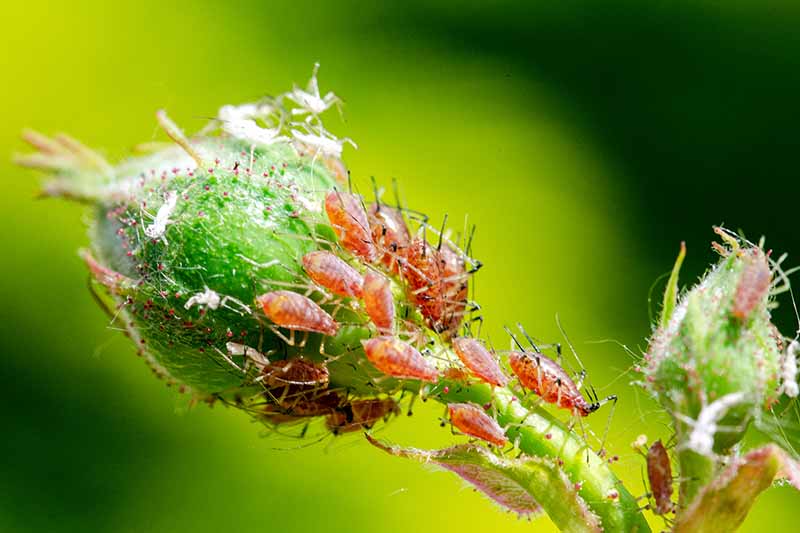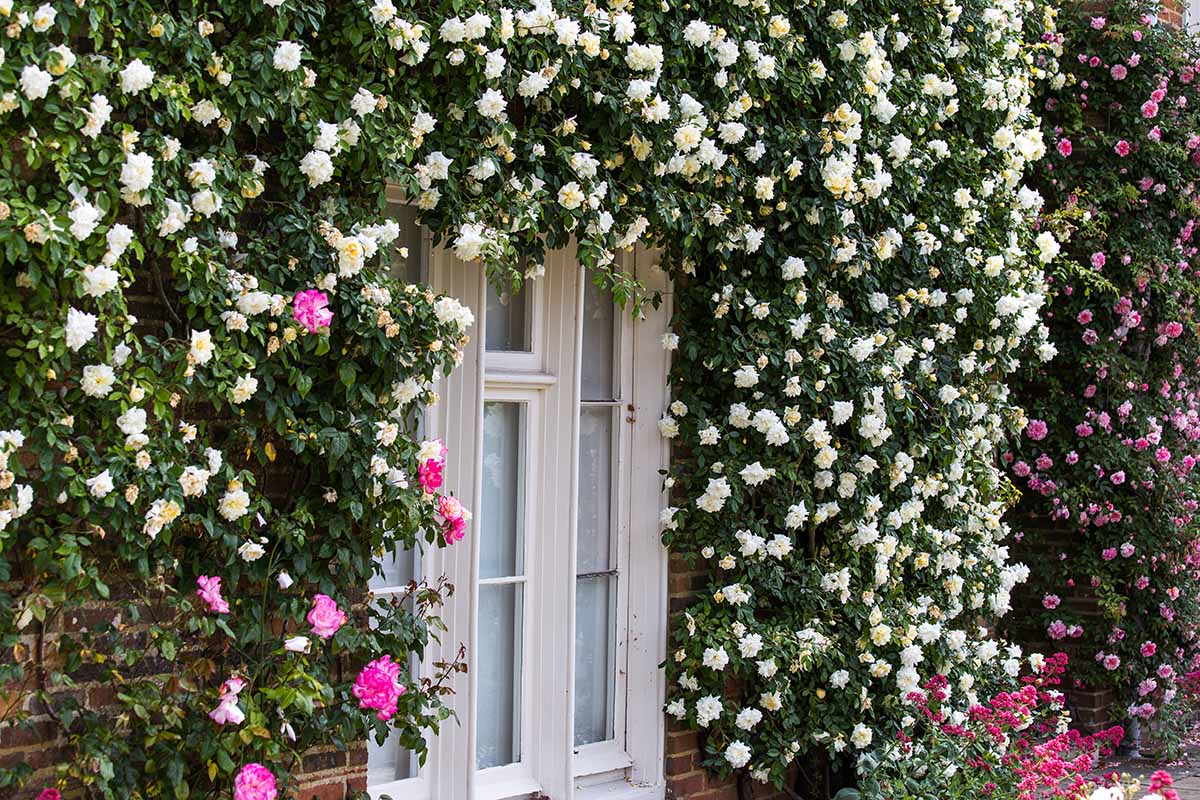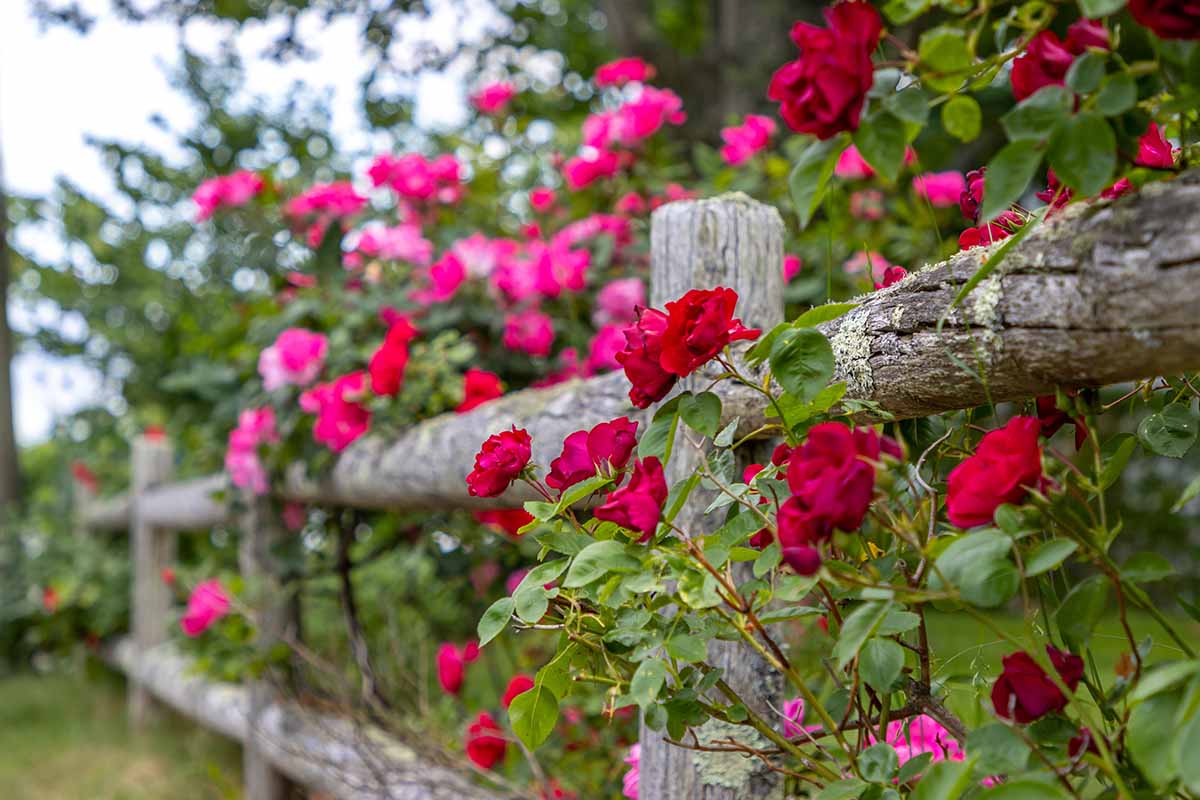Don’t be afraid of growing these plants. It’s not difficult to get that gorgeous display, though many people are intimidated by roses and rambling ones in particular. That’s a shame because they’re fairly easy to grow, as far as roses go, so long as you can manage the training process. We link to vendors to help you find relevant products. If you buy from one of our links, we may earn a commission. Sound like something you’re up for? Then let’s discuss growing climbing roses. Here’s what’s ahead: When it comes to selecting and raising rambling roses, it never hurts to reach out to your local American Rose Society (ARS) chapter. They know best which climbers grow well in your area and what particular diseases and pests you might face. Combined with their advice and our guidance, we hope you’ll find massive success with your graceful beauties.
What Are Climbing Roses?
Let’s clear things up straight away. Climbers aren’t like ivy or clematis. They don’t have aerial roots, tendrils, or suckers. Climbing roses only “climb” if you help them. They won’t “cling” to a wall or a fence like true vines and they can’t support themselves. In other words, if you want a plant that will climb up a bare brick wall without any assistance from you, this isn’t it. They can maintain a little bit of support on their own, particularly at the end of the canes, but the rest needs some help. Ramblers, as they’re also known, are actually shrubs that have particularly long and strong canes. Growers can train and support these long canes to create the effect of a true climbing growth habit. This growth habit can actually be a positive thing because it means that while you might need to put in some extra work to encourage your plant to climb, you don’t have to worry about it creeping up the side of your house and lifting up your roof or punching through a wall.
Cultivation and History
Roses have been cultivated for centuries. We have evidence of them in Japanese and Chinese gardens from as far back as 5,000 years ago. Ancient Greeks and Romans valued them, and the red and white blossoms are famous symbols of the British aristocracy, with the red rose representing the House of Tudor and white representing the House of York. Climbing types came from plants that were selected and further bred over the years because they had particularly strong and long canes. Over time, hybrids and cultivars that we now consider climbers were developed. Climbers can be any type of rose, including damask, hybrid tea, species, shrub, or floribunda. Not sure what all that means? Visit our guide to rose classifications to learn more.
Propagation
Climbers are no different from their lower-growing counterparts when it comes to propagation. You can reproduce them from seed, cuttings, layering, and transplanting both live and bare root specimens. They come as both grafted and own-root plants. To learn more about all these options, you might want to read our general guide to growing roses or our guide to propagating roses from cuttings. We also have an article to walk you through transplanting these plants. The only thing to keep in mind is that you might need to prune back the plant quite a bit if you decide to go the transplant route. Some stores sell their climbers with a bit of height on them, but you want the plant to focus on its roots rather than developing its canes at first. Cut back each cane by at least a third before you install it in its permanent home in the garden.
How to Grow
What truly sets climbers apart from other types is that they need a lot of room to grow. The same characteristics that make them good climbers – strong and long canes – also make them quite vigorous. It might be tempting to place them in a small area against a wall, but you’ll probably be sorry down the road when you have to prune them monthly to keep them from grabbing you each time you walk by. When I say that these plants can grow large, that’s not an exaggeration. The tallest rose is a climbing ‘Cecile Brunner’ in Los Angeles that has reached 91 feet tall! Having said all that, most of the growth usually happens vertically. You don’t usually need a large footprint. There are some exceptions, but you’ll usually find that most grow much taller than they do wide. You might see plants labeled as “miniature” climbers. The only thing miniature about them is the size of the flowers. They produce adorable little blossoms rather than massive ones, but the canes themselves still grow quite large. Pick an area that is big enough to accommodate the mature size of the plant. If the mature size isn’t included on the tag, look it up online or contact your local chapter of the ARS. The space you’re planting in should be the same size or larger than the rose will eventually be. Also keep in mind that many climbing roses are capable of becoming much, much larger than the tag claims. For instance, ‘Cecile Brunner’ is generally labeled as growing about 20 feet high or so. But as you can probably tell, that’s not a hard and fast rule, and results may vary depending on your local conditions. In addition to making sure you have the right amount of room, you also need to make sure your new plant receives full sunlight. Some roses can get by in partial sun, but not ramblers. They absolutely need at least six full hours of sunlight each day or you’ll end up with a spindly shrub that doesn’t grow as tall or bloom as much as it could. Of course, as with most things in life, there are some exceptions, so be sure to do a little research if you find a cultivar at your local nursery that you just can’t live without. When it comes to soil, the usual rose rules apply. The pH should be around 6.0 to 6.5 and the soil must be loose and loamy for the best results. If you need to amend your soil to improve drainage, dig about two feet wide and 18 inches deep. Work in lots of well-rotted compost, which works to improve both sandy and clay soil. Once the plant is in the ground and has started to grow, you need to train it. It will need some sort of support or you’ll end up with lanky, weeping canes that will eventually break. A fence, trellis, tall stake, or even an old shipping pallet propped up on its side will do. You don’t need to tie the canes in place, but it can certainly help, especially if you live in a windy area. If you do, use something that won’t cut through the flesh of the canes, like twine or tape. Avoid wire. Learn more about training climbing roses here. These plants like a good amount of water and they should receive about two inches per week, whether that comes from Mother Nature or your irrigation system.
Pruning and Maintenance
If you’ve pruned roses before, you might be tempted to skip this section. But don’t! Fertilize young plants in their first year after planting with a mild potassium fertilizer, like one that contains seaweed. Neptune’s Harvest is a reliable option that I’ve had success with. Neptune’s Harvest
Growing Tips
Amend sandy or clay soil with compost.Soil pH should be around 6.0-6.5.Provide support and secure the canes in place, if needed.
Pruning climbers is vastly different from what’s required with a shrub or ground cover. You ultimately want to have about four robust canes on a plant at any given time. That means removing sickly, twisted, or crossing canes, as well as any weak, broken, or crowded branches. Then, remove all but four of the oldest, healthiest, or largest canes. With the four remaining canes in place, cut each one to about four feet shorter than you ultimately want the plant to grow. This encourages bushier growth and limits the height. Eventually, some of the older canes will stop producing nice flowers and leaves. At that point, cut these out and let other, younger canes replace them. You can allow the plant to grow wider by allowing more canes to form, but avoid allowing the plant to become crowded at the center. In other words, additional canes on the outside of the bush are fine. More canes in the center are not. It’s absolutely smothered in light pink double blossoms from spring until fall. The sweet little medium-pink buds were once a favorite for men to stuff into their lapels, earning it the nickname “the sweetheart rose.” If you aren’t sure what to pick, Great Big Roses is a compost extract that has always made my flowers look fantastic. Great Big Roses
Cultivars to Select
There are many excellent climbers out there. Once again, your local rose society can be an excellent resource for locating cultivars that will excel in your neck of the woods. The choices below tend to work in most rose-friendly regions.
Cecile Brunner
‘Cecile Brunner’ is a classic option that has been around a long time, for good reason. It’s a repeat bloomer that is resistant to fungal diseases and can handle partial shade.
Claire Austin
Remember how we said that climbers need full sun? This is another one of the few exceptions. ‘Claire Austin’ will climb up to 12 feet tall, even in a partially sunny spot with only four hours of sunlight. The creamy white, cupped, very full blossoms are a sight to behold, particularly on an obelisk or pillar. She’s also disease resistant and has a strong myrrh fragrance. This cultivar isn’t too thorny, has a pleasing fragrance, and stays fairly slender, which makes it ideal if you’re looking for an option to plant next to a walkway, to grow over an arbor, or to cover a pergola over your patio. This cultivar will blossom continuously for a summer-long show. It was bred by the same breeder – Will Radler – who brought us Knock Outs, so you know it’s a reliable choice.
Joseph’s Coat
This is a flower draped in a robe of many colors. The double blossoms start out salmon pink before opening into a dramatic ombre of yellow, pink, and orange. As they fade, the colors transition to less pink and more yellow, with a softer, pastel hue. ‘Joseph’s Coat’ The canes reach up to 12 feet tall and the blossoms form on both new and old wood, so you can prune away without fear. Ready to wrap yourself in color? Head to Fast Growing Trees to purchase a plant for your garden.
Lady in Red
‘Lady in Red’ is all dressed up in her finest, with dark, velvety red petals on ruffly double flowers. She grows to a manageable 10 feet tall and has dense foliage that makes her perfect as a filler for a fence between you and your neighbor’s property. ‘Lady in Red’ Bring this lovely lady home as a bare root plant from Home Depot.
Malvern Hills
Like a stroll through the fields of Herefordshire, ‘Malvern Hills’ is a rambler that captures the spirit of a perfect summer afternoon. It features creamy yellow blossoms that start out as medium yellow buds, all on a 15-foot-tall plant. It’s a repeat bloomer with double flowers held in large clusters. That should be enough to recommend it, but it also happens to be as tough as nails! It’s highly resistant to most fungal diseases that commonly plague other roses. For an overview of dealing with diseases, we have a dedicated guide. ‘Sky’s the Limit’ Without a lot of work, this is a hardy, disease-resistant option that shows off with big clusters of double, creamy yellow flowers. Home Depot has this cultivar available as a bare root if you’re aiming to add this beauty to your space.
Stormy Weather
With ‘Stormy Weather’ in your garden, you won’t mind rough weather. This stunner calls to mind purple rain clouds just before a deluge with its purple-magenta blossoms. But at the center of each is a bright splotch of yellow and white, like the sun peeking out after a storm. ‘Stormy Weather’ ‘Stormy Weather’ will eventually reach 10 feet tall and is a reliable, prolific bloomer. Invite the storm into your yard by grabbing a bare root specimen at Home Depot.
Managing Pests and Disease
Anything that may affect other roses will impact ramblers. Herbivores like deer, rabbits, and squirrels will nibble on your shrubs, as will pests like aphids, cane borers, Japanese beetles, sawflies, scale, snails, spider mites, and thrips.
Best Uses
Remember, climbers don’t have tendrils or suckers, so you’ll need to aid them in their climbing adventures. There are lots of ways to do this in a beautiful and interesting way. Climbing roses are a particularly good option for growing against buildings because they won’t destroy the walls or roofs that they’re set against. Use a trellis, structural wires, or wire fencing to act as a support. In the garden, they can be beautiful crawling up a trellis, obelisk, arbor, or other structure. You can also let them create a barrier between you and a neighbor’s yard along a fence or wall. Where are you growing your ramblers? Against a brick wall? Over an arbor? Let us know in the comments below! Also, if you’re looking to expand your Rosa knowledge, we have a wealth of information that you might find useful, including:
How and When to Deadhead RosesHow to Winterize RosesHow to Plant Roses During the Fall25 of the Best-Smelling Roses to Enrich Your Garden

